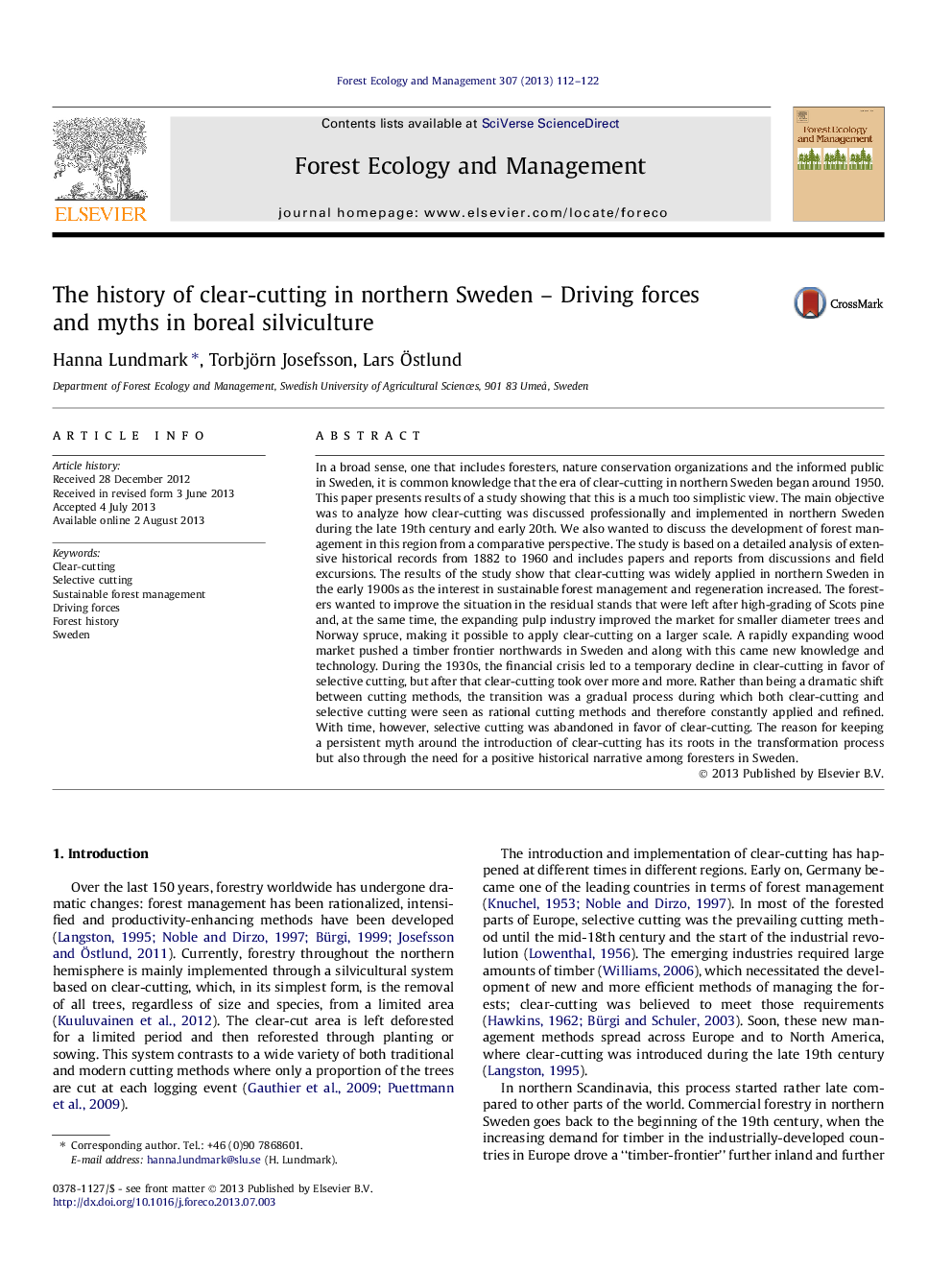| کد مقاله | کد نشریه | سال انتشار | مقاله انگلیسی | نسخه تمام متن |
|---|---|---|---|---|
| 6544032 | 159218 | 2013 | 11 صفحه PDF | دانلود رایگان |
عنوان انگلیسی مقاله ISI
The history of clear-cutting in northern Sweden - Driving forces and myths in boreal silviculture
ترجمه فارسی عنوان
تاریخ برش روشن در شمال سوئد - نیروهای رانندگی و افسانه ها در جنگلداری حومه
دانلود مقاله + سفارش ترجمه
دانلود مقاله ISI انگلیسی
رایگان برای ایرانیان
کلمات کلیدی
برش دقیق، برش انتخابی، مدیریت جنگل پایدار، نیروهای رانندگی، تاریخ جنگل، سوئد،
ترجمه چکیده
به طور گسترده ای، که شامل جنگلداری، سازمان حفاظت از طبیعت و آگاهی عمومی در سوئد است، شناخته شده است که دوران برش روشن در شمال سوئد در حدود 1950 آغاز شده است. این مقاله نتایجی از یک مطالعه نشان می دهد که این یک دید بسیار ساده. هدف اصلی این بود که تجزیه و تحلیل کنیم که چطور روشن شدن برش حرفه ای در اواخر قرن نوزدهم و اوایل 20 در شمال سوئد مورد بحث و بررسی قرار گرفت. ما همچنین می خواستیم در مورد توسعه مدیریت جنگل ها در این منطقه از دیدگاه مقایسه ای بحث کنیم. این مطالعه بر مبنای تجزیه و تحلیل دقیق سوابق تاریخی گسترده از سال 1882 تا 1960 است و شامل مقالات و گزارشات از بحث ها و گشت و گذار در زمینه است. نتایج این تحقیق نشان می دهد که در اوائل دهه 1900 در شمال سوئد به طور گسترده ای در برداشتن روش های صحیح استفاده شد، زیرا علاقه به مدیریت جنگل های پایدار و بازسازی بیشتر شد. جنگلداران می خواستند وضعیت موجود در مخازن باقی مانده را که پس از طبقه بندی عالی کاج ترک شده بودند، بهبود بخشند و در عین حال صنعت صنایع پالایش در حال گسترش بازار های درختان درخت کوچکتر و صنوبر نرو بود، برش در مقیاس بزرگتر. یک بازار به سرعت در حال گسترش چوب متروکه در شمال سوئد را تحت فشار قرار داد و در کنار آن، دانش و تکنولوژی جدید به دست آمد. در طول دهه 1930، بحران مالی منجر به کاهش موقت در برش روشن به نفع برش انتخابی شد، اما پس از آن، برش روشن بیشتر و بیشتر شد. در عوض تغییر شیوه ی بین روش های برش، گذار یک فرایند تدریجی بود که طی آن هر دو برش واضح و برشی به عنوان روش های برداشت عقلانه دیده می شدند و به همین دلیل دائما کاربرد و تصفیه شده بودند. با گذشت زمان، برش انتخابی به نفع برش واضح متوقف شد. دلیل حفظ افسانه مداوم در مورد مقدمه برش روشن، ریشه در فرآیند تحول و همچنین نیاز به یک روایت مثبت تاریخی در میان جنگلاران در سوئد دارد.
موضوعات مرتبط
علوم زیستی و بیوفناوری
علوم کشاورزی و بیولوژیک
بوم شناسی، تکامل، رفتار و سامانه شناسی
چکیده انگلیسی
In a broad sense, one that includes foresters, nature conservation organizations and the informed public in Sweden, it is common knowledge that the era of clear-cutting in northern Sweden began around 1950. This paper presents results of a study showing that this is a much too simplistic view. The main objective was to analyze how clear-cutting was discussed professionally and implemented in northern Sweden during the late 19th century and early 20th. We also wanted to discuss the development of forest management in this region from a comparative perspective. The study is based on a detailed analysis of extensive historical records from 1882 to 1960 and includes papers and reports from discussions and field excursions. The results of the study show that clear-cutting was widely applied in northern Sweden in the early 1900s as the interest in sustainable forest management and regeneration increased. The foresters wanted to improve the situation in the residual stands that were left after high-grading of Scots pine and, at the same time, the expanding pulp industry improved the market for smaller diameter trees and Norway spruce, making it possible to apply clear-cutting on a larger scale. A rapidly expanding wood market pushed a timber frontier northwards in Sweden and along with this came new knowledge and technology. During the 1930s, the financial crisis led to a temporary decline in clear-cutting in favor of selective cutting, but after that clear-cutting took over more and more. Rather than being a dramatic shift between cutting methods, the transition was a gradual process during which both clear-cutting and selective cutting were seen as rational cutting methods and therefore constantly applied and refined. With time, however, selective cutting was abandoned in favor of clear-cutting. The reason for keeping a persistent myth around the introduction of clear-cutting has its roots in the transformation process but also through the need for a positive historical narrative among foresters in Sweden.
ناشر
Database: Elsevier - ScienceDirect (ساینس دایرکت)
Journal: Forest Ecology and Management - Volume 307, 1 November 2013, Pages 112-122
Journal: Forest Ecology and Management - Volume 307, 1 November 2013, Pages 112-122
نویسندگان
Hanna Lundmark, Torbjörn Josefsson, Lars Ãstlund,
